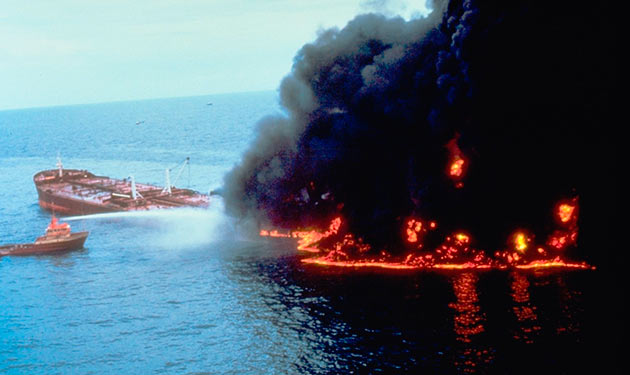Preventing sea pollution from oil tankers is critical to protecting marine ecosystems. Measures to prevent marine pollution from oil tankers are compliance with international regulations such as MARPOL to prevent oil spills, as well as proper maintenance – regular inspection and maintenance of the tank to prevent leaks and spills. Crew members must be trained in spill response procedures and drills must be conducted regularly. The use of double-hulled tankers is important to reduce the risk of oil spills in the event of a collision or grounding.
The availability and functionality of oil spill response equipment on a tanker is important. Safe navigation rules must be followed to avoid accidents that could lead to oil spills. Monitoring systems to detect leaks or spills early and take prompt action are key, as is the development and implementation of environmental management Safety, Risks and Security Aspects in Liquefied Natural Gas Industryplans to address potential risks and prevent pollution.
Pollution
An inconvenience or damaged caused by human activities to human, animals, plants and to our environment as whole, by spreading of compound to air, water or land.
Most chemicals carried by merchant represents a pollution risk.
Sources of marine pollution
Tanker accidents:
- Grounding.
- Stranding.
- Collision.
- Fire & Explosion.
- Hull Failure.
- Capsizing.
Normal tanker operation
- Cargo operation (Loading, Discharging, Lightering).
- Ballasting/Deballasting.
- Tank Washing.
- Bunkering/Pumping out Bilge.
MARPOL CONVENTION – 73/78
Consists of two parts
1 MARPOL 73 International Convention for prevention of ship pollution
2 Tanker Safety and Pollution Prevention 1978 (TSPP 78), 1978 protocol to MARPOL 73
- ANNEX I – Regulation for the Prevention of pollution by OIL.
- ANNEX II – Regulation for the Control of pollution by NOXIOUS LIQUID SUBTANCES.
- ANNEX III – Regulation for the Prevention of pollution by HARMFUL SUBTANCES IN PACKAGED FORM.
- ANNEX IV – Regulation for the Prevention of pollution by SEWAGE.
- ANNEX V – Regulation for the Prevention by GARBAGE.
- ANNEX VI – Regulation for the Prevention of Air Pollution from ships.
ANNEX I – Regulation for the prevention of pollution by oil
Regulation 34
Control of discharge of oil
Outside special areas
Cargo areas
a For oil tanker, except as provided for in subparagraph (b) of this paragraph:
- (I) – the tanker is not within a special area;
- (II) – the tanker is more than 50 nautical miles from the nearest land;
- (III) – the tanker is proceeding en route;
- (IV) – the instantaneous rate of oil content does not exceed 30 liters per nautical mile;
- (V) – the total quantity of the oil discharged into the sea does not exceed for existing tankers 1/15 000 of total quantity of the particular cargo of which the residue formed a part, and new tankers 1/30 000 of the total quantity of the particular cargo of which the residue form a part;
- (VI) – and the tanker has in operation of oil discharge monitoring and control system and a slop tank arrangement as required by regulation 31 and 29 of this Annex.
Regulation 15
Control of discharge of oil
Outside special areas
Machinery spaces
a From the ship of 400 tons gross tonnage and above other than oil tanker and from machinery space bilges excluding cargo pump room bilges of an oil tanker unless mixed oil cargo residue:
- (I) – the ships is not within a special area;
- (II) – the ships is proceeding en route;
- (III) – the oil content of the effluent without dilution does not exceed 15 parts per million;
- and (IV) – the ship has in operation of an oil filtering equipment as required by regulation 14 of this Annex.
Regulation 1
Special Areas:
- The Mediterranean Sea.
- The Baltic Sea.
- The Black Sea.
- The Red Sea.
- The Arabian Gulf.
- The Gulf of Aden.
- The Antarctic Sea Area.
- North West European Waters.
- The Oman Area of the Arabian Sea.
- Southern South African Waters.
Regulation 37
Shipboard Oil Pollution Emergency Plan (SOPEP)
(1) Every oil tanker of 150 tons gross tonnage and above and every ship other than an oil of 400 tons gross tonnage and above shall carry on board a shipboard oil pollution emergency plan approved by the Administration. In the case of ships built 4 April 1993 this requirement shall apply 24 months after that date.
(2) Such a plan shall be in accordance with guidelines developed by the Organization and written in the working language of the master and officers. The plan shall consists at least of:
- (a) – the procedure to be followed by the master or other persons having charge of the ship to report an oil pollution incident, as required in article 8 and Protocol 1 of the present Convention, based on the guidelines developed by the Organization;
- (b) – the list of authorities or person to be contacted in the event of an oil pollution incident;
- (c) – a detailed description of the action to be taken immediately by persons on board to reduce or control the discharge of oil following the incident;
- and (d) – the procedures and point of contact on the ship for coordinating shipboard action with national and local authorities in combating the pollution.
ANNEX II: CHAPTER 2 – Categorization of noxious liquid substances
Regulation 6 – Categorization and listing of noxious liquid substances and other substances.
CATEGORY X – Noxious liquid substances which, if discharged into the sea from tank cleaning or deballasting operations, are deemed to present a major hazard to either marine resources or human health and, therefore, justify the prohibition of the discharge into the marine environment.
CATEGORY Y – Noxious liquid substances which, if discharged into the sea from tank cleaning or deballasting operations, are deemed to present a hazard to either marine resources or human health or cause harm to amenities or other legitimate uses of the sea and therefore justify a limitation on the quality and quantity of the discharge into the marine environment.
CATEGORY Z – Noxious liquid substances which, if discharged into the sea from tank cleaning or deballasting operations, are deemed to present a minor hazard to either marine resources or human health and therefore justify less stringent restrictions on the quality and quantity of the discharge into the marine environment.
Other substances – Substances indicated as OS (Other Substances) in the pollution category column of chapter 18 of the International Bulk Chemical Code which have been evaluated and found to fall outside category X, Y or Z as defined in regulation 6.1 of this annex because they are, at present, considered to present no harm to marine resources, human health, amenities or other legitimate uses of the sea when discharged into the sea from tankcleaning or deballasting operations. The discharge of bilge or ballast water or other residues or mixtures containing only substances referred to as «other substances» shall not be subject to any requirements of the annex.

Pollution Preventions
General
- Each specific type of tanker must comply with constructional requirements of their respective class with regards to segregate ballast capacity, slop tank capacity, limitation of tank size, survival capability in case of damage and overboard piping arrangements.
- Oil tankers must have an approved equipment for monitoring and controlling discharge of oil an oily mixture into the sea and establishing oil/water interface slop tanks.
- Requirements are set to minimize pollution with regard to the handling of noxious liquid cargoes concerning the categorization of cargo, stripping requirements, discharge requirements and reception facilities, construction and location of cargo tanks, vapor emission and overflow control system.
- Pollution from cargoes can minimized through using correct working routing and by following the applicable pollution regulations.
Reporting/Notifying at sea
All oil spill must be reported. An initial report must be sent to the nearest Coastal State as soon as possible and by the fastest telecommunications means.
The content of an initial report shall include the following.
- a – name of ship;
- b – frequency of radio channel guarded;
- c – name/address, telex no. and tel. No. of owner and representative;
- d – type of ship;
- e – date and type (UTC) of the incident;
- f – description of the incident, including damaged sustained;
- g – ship’s position, course, speed as appropriate at the time of incident;
- h – type of oil involved;
- i – other cargo carried.
A follow-up report should be sent as further details become available. In port notify the terminal, and the port authorities.
Containment procedures
The following are the immediate measures to be taken in case of an oil spill:
- Shut down pumps and close valves from which oil in escaping.
- Call the Master and Chief officer.
- Alert the engine room and if necessary have them pressurize the fire main.
- Prepare fire-fighting gear if necessary Notify the terminal.
- If the spill is on deck, treat it with absorbent material.
- Larger spill on deck should be contain by using oil booms.
- In major spill on deck, use portable pump.
In case of a chemical spill, it is essential to refer to the cargo chemical data sheets, which gives specific procedure for containment and handling of spill.
Knowledge and understanding of tanker safety culture and safety managementLeakage of liquefied gases form pump glands, pipe works flanges or pipe work ruptures or masthead vent emission due to cargo tank over-pressure will initially produce vapor. This may form a cold, dense vapor cloud, which presents a fire hazard if ignition is introduced. Some iquefied cases are very toxic or corrosive, so in case of vapor emission strictly follow the procedures state on its cargo data sheet.
Read also: General Provisions, Rules and Requirements for Safe Carriages of Cargoes
Basic Knowledge of Measures to be Taken in the Event of Spillage
The following action should be taken immediately:
- The alarm should be raised and the terminal informed immediately.
- All cargo operations should be stopped, ESD should be activated and all valves closed.
- All accommodation access doors should be shut and all ventilation (except closed-circuit systems) shut down.
- Smoking and naked lights should be prohibited everywhere on the ship, and electrical switches used as little as possible.
- Appropriate firefighting equipment should be deployed and breathing apparatus sets assembled for immediate use. The emergency squad should wear breathing apparatus and protective clothing;
- and if liquid spillage occurs, fire hoses or water sprays should be played along the deck to disperse the liquid overboard and to maintain steel temperatures so that brittle fracture is avoided. Water spray from hoses can also be used to deflect a gas cloud.
If the spillage is contained in a drip tray, the contents should be covered or protected to prevent accidental contact and allowed to evaporate unless the drip tray is fitted with a drain when the liquid should be drained off.
Liquefied gases quickly reach equilibrium and visible boiling ceases; this quiescent liquid could be mistaken for water and carelessness could be dangerous. Water jet should never be directed onto the contents of a drip tray.
If liquefied gases spill on to the sea, large quantities of vapour will be generated by the heating effect of the water. This vapour may create a fire or health hazard, or both. Great care should be taken to ensure that such spillage does not occur especially when disconnecting cargo hoses.

